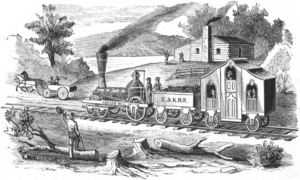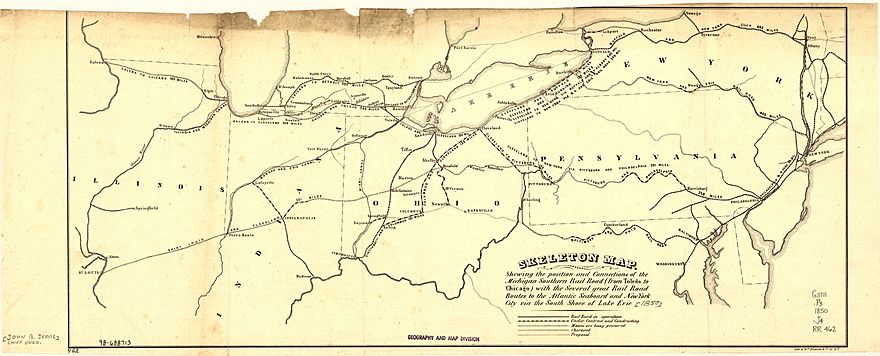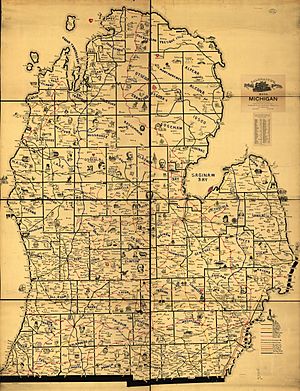History of railroads in Michigan facts for kids
Railroads have played a super important role in how the state of Michigan grew, helping people move around and trade goods. Even though some towns were already on the coast, the arrival of railroads really made Michigan's population, businesses, and factories boom!
Michigan is close to Ontario, Canada, which made it easy to transport goods from the eastern side of Lake Michigan all the way to cities like Montreal and Quebec. Before the big railroad companies merged in the 1900s, some of the main railroads in Michigan were the Michigan Central Railroad and the New York Central Railroad.
Contents
Michigan's Railroad Story
The Very First Train Tracks
The story of railroads in Michigan started way back in 1830. That was seven years before Michigan even became a state! The first company to get permission to build tracks was the Pontiac and Detroit Railway. This was a big deal because it was the first time this happened in the whole Northwest Territory.
In 1832, another company, the Detroit and St. Joseph Railroad, also got permission. Their goal was to build tracks all the way across the Lower Peninsula of Michigan to connect with Lake Michigan at the St. Joseph River. But neither of these projects really got started.
Then, in 1833, the Michigan government gave permission to a new company: the Erie and Kalamazoo Railroad. This company planned to connect Port Lawrence (which is now Toledo, Ohio) on Lake Erie to a spot on the Kalamazoo River, which flows into Lake Michigan.
By November 2, 1836, the Erie & Kalamazoo had finished about 33 miles (53 km) of track from Port Lawrence to Adrian, Michigan. A single car, pulled by horses, made the first train trip west of New York. The first steam trains started running in early 1837, going about 10 miles per hour (16 km/h).
Further north, the Detroit and Pontiac Railroad finished a 12-mile (20 km) line from Detroit north to Royal Oak, Michigan. Trains started running in 1838, but they were also pulled by horses until the next year. After some money problems, the railroad finally reached Pontiac, Michigan in 1843, making it about 27 miles (43 km) long.
When the State Tried to Build Railroads
By 1837, Michigan had some railroads, but the government and people weren't happy with them. In the first seven years (1830–1837), the Michigan government approved 23 private railroad companies. But only five actually built and opened lines, and they only covered about 61 miles (98 km) within Michigan.
The two main lines, the Erie & Kalamazoo and the Detroit & Pontiac, were built to help local businesses. But the new state government wanted something bigger. Also, after the "Toledo War" (a border dispute), Toledo ended up in Ohio, meaning Michigan's only railroad-connected port on Lake Erie was in another state.
So, Michigan decided to build three big railroad lines across the state, like New York had done with its Erie Canal. Michigan's plan was to build three lines from the east side of the state to places on Lake Michigan:
- The "Northern" line: From St. Clair, Michigan (on the St. Clair River near Ontario) to Grand Haven, Michigan.
- The "Central" line: From Detroit to St. Joseph, Michigan.
- The "Southern" line: From Monroe, Michigan (on Lake Erie) to New Buffalo, Michigan.
The government, led by Governor Stevens T. Mason, planned to pay for all of this with a $5 million loan. They thought it would take only five years to build, and that the money earned from the finished parts would pay off the loan in 20 years and even make a profit! But these ideas were way too hopeful.
Michigan tried to get the loan during a tough economic time called the Panic of 1837. Banks were failing, land sales stopped, and money was hard to find. Building the lines also had problems because different towns wanted the railroads to go through their areas. There were also reports of money being wasted and general inefficiency.
By the end of 1845, the state had spent about $4 million. The "Southern" line had only reached Hillsdale, Michigan, and the "Central" line reached Battle Creek, Michigan. The "Northern" line hadn't even started! Only about 188 miles (302 km) of a planned 600-plus miles (965 km) were built, and Michigan's money situation was a mess.
In 1846, the state sold both the "Southern" and "Central" lines to private companies, losing money. From this, the Michigan Southern Railroad and Michigan Central Railroad were born. Because of this experience, Michigan's new constitution in 1850 said the state could not directly invest in or build "internal improvements" like railroads anymore.
Building Across the Lower Peninsula
When the state sold the "Central" and "Southern" lines, it required the new private companies to finish building their tracks to Lake Michigan. The Michigan Central Railroad was in Kalamazoo, Michigan, and the Michigan Southern was in Hillsdale, Michigan.
Both companies realized how important Chicago, Illinois was becoming. Chicago was a port city on the southwest coast of Lake Michigan, and its river connected to the Mississippi River. The Michigan Central turned its line south toward New Buffalo, Michigan, a small town near the Michigan/Indiana border. The Michigan Southern, after talking with the state, decided to skip Lake Michigan and go south into Indiana, passing through Sturgis, Michigan and into South Bend, Indiana.
On February 20, 1852, the Michigan Southern became the first Michigan company to run trains into Chicago. The Michigan Central followed three months later.
Jackson, Michigan became a very important rail center. The Michigan Central Railroad added Jackson as a main stop in 1841. By 1871, six different railroads passed through Jackson, and by 1910, it was a major hub for switching and repairing trains for 10 railroads.
A third line to cross the Lower Peninsula came from the Detroit and Pontiac Railroad. After going through money troubles, it came back in 1849 with new supporters and money. Under its new name, the Detroit & Milwaukee (D&M), the railroad pushed across the middle of the peninsula. It finally reached Grand Haven, Michigan on Lake Michigan on November 22, 1858. This line stretched about 186 miles (299 km) from Detroit through Grand Rapids, Michigan to Grand Haven.
A man named Winfield Scott Gerrish changed how lumber was moved in Michigan. In 1877, he built a seven-mile-long logging railroad from Lake George, Michigan to the Muskegon River in Clare County, Michigan. This was a big step for the lumber industry.
Land Grants and Mining Railroads
The next big wave of railroad building in Michigan happened because of a "land grant" program from the federal government. Starting in 1856, Michigan was given over 5 million acres (20,000 km²) of land. This land could be given to railroad companies, who would then sell it for profit, in exchange for building certain routes. These new routes were planned for areas not yet covered by the existing railroads, especially in the northern parts of the state.
Half of these land grants went to railroads in the Upper Peninsula, where lots of valuable copper and iron ore had been found. Two routes in the Lower Peninsula would run north-south, connecting areas that the east-west lines didn't reach.
Even with the land grants, building railroads was still tough. The Grand Rapids and Indiana Railroad (GR&I) had a hard time getting money. It was only with help from the Pennsylvania Railroad that the GR&I finished enough of its planned route to keep its permission to build. Still, the railroad faced money problems later on.
In the less populated Upper Peninsula, railroads were built mainly to carry copper and iron ore from the mountains to Chicago, Illinois. The first railroad in the UP, the Iron Mountain Railroad, was built with private money between 1851 and 1857. With the help of land grants, three big companies from outside Michigan came to dominate the mining areas: the Duluth, South Shore and Atlantic Railway, the Chicago and North Western Transportation Company, and the Chicago, Milwaukee, St. Paul and Pacific Railroad. In the east, the Detroit, Mackinac and Marquette Railroad built a line from Marquette, Michigan to St. Ignace, Michigan, connecting the state's two peninsulas.
A Time of Fast Growth and Tough Times
After the American Civil War, Michigan's railroad network grew a lot. In 1865, the state had about 1,000 miles (1,600 km) of track. By 1890, it had 9,000 miles (14,000 km)! These new lines were built by private companies using borrowed money, selling shares, and sometimes getting help from local governments. During this time, many lines were built without really thinking if they would make money. This led to many companies going bankrupt or having financial difficulties.
Railroads in Michigan Today
Railroads are still active in Michigan, though not as much as they used to be. Michigan is served by four very large railroads: the Canadian National Railway, the Canadian Pacific Railway, CSX Transportation, and Norfolk Southern Railway. There are also many smaller railroads. Most of the train service in Michigan today is for carrying freight (goods), with Amtrak and some special scenic railroads being the exceptions for passengers.
Passenger Train Service

Amtrak offers passenger train service in Michigan. It connects cities like Detroit, Ann Arbor, Michigan, East Lansing, Michigan, Grand Rapids, Michigan, Jackson, Michigan, Battle Creek, Michigan, Kalamazoo, Michigan, Flint, Michigan, and Port Huron, Michigan to Chicago, Illinois. In 2005-2006, these three routes carried over 664,000 passengers, which was a record!
The Pere Marquette and Blue Water train services get money from the State of Michigan to help them run. The route between Detroit and Chicago has been chosen by the Federal Railroad Administration to become a high-speed rail corridor. A 97-mile (156 km) section of track between Porter, Indiana and Kalamazoo, Michigan is the longest part of track owned by Amtrak outside of the Northeast. Amtrak started increasing speeds on this section in 2002, and by 2012, trains were regularly running at 110 miles per hour (180 km/h) there.
Commuter Train Service
Michigan hasn't had regular commuter train service since 1984. That's when Amtrak stopped the Michigan Executive train, which ran between Ann Arbor, Michigan and Detroit.
Currently, there are two new proposed systems being considered. One is called WALLY, which would provide daily service between Ann Arbor and Howell, Michigan. The other is a proposed project by the Southeast Michigan Council of Governments that would offer daily service between Detroit and Ann Arbor, with stops in Ypsilanti, Michigan, Detroit Metro Airport, and Dearborn, Michigan. There have even been talks about extending this project to Jackson, Michigan.
Station Architecture







